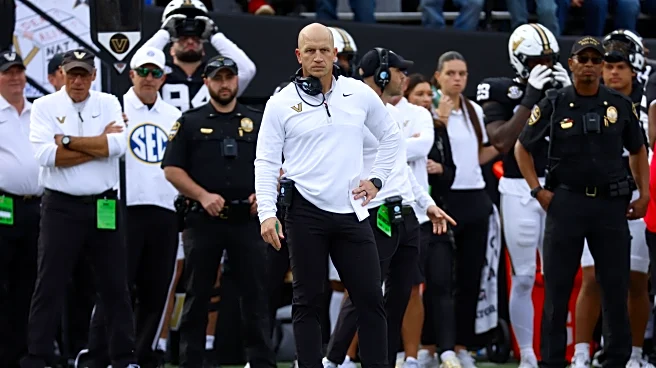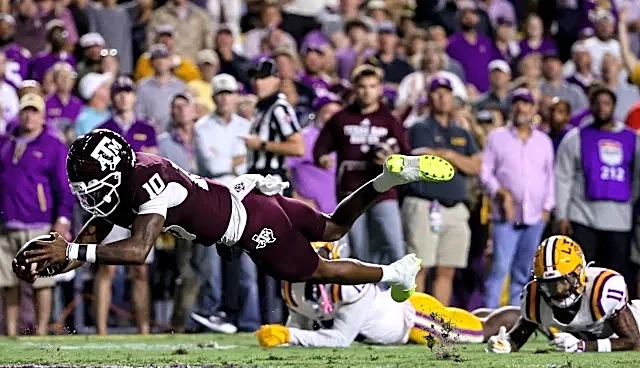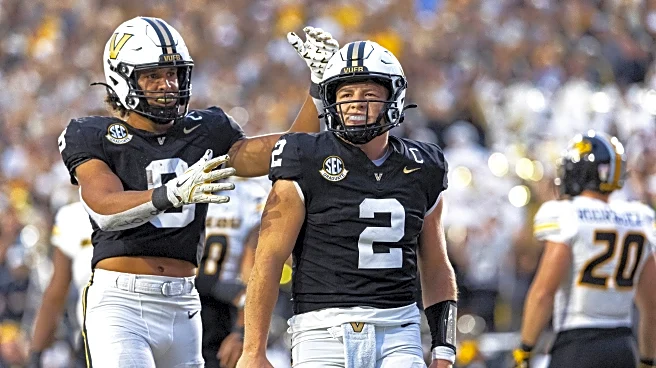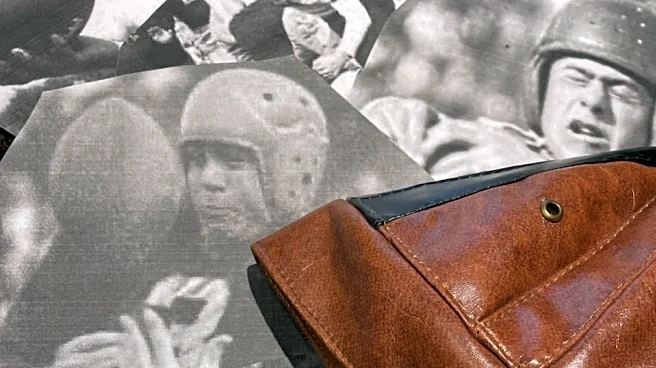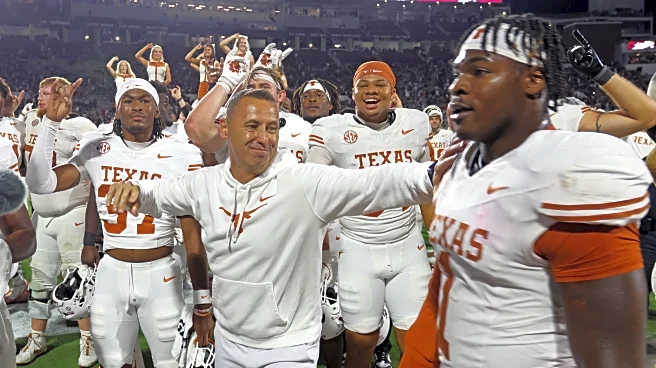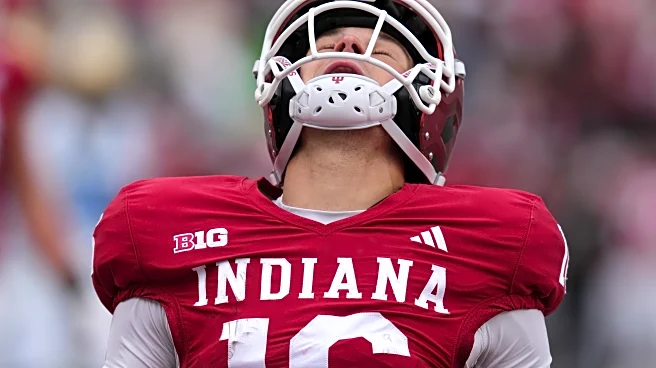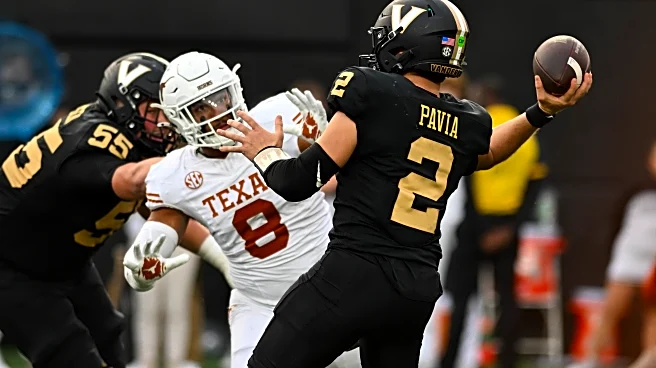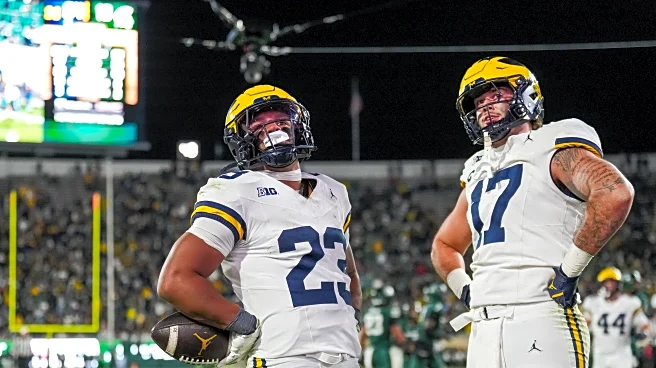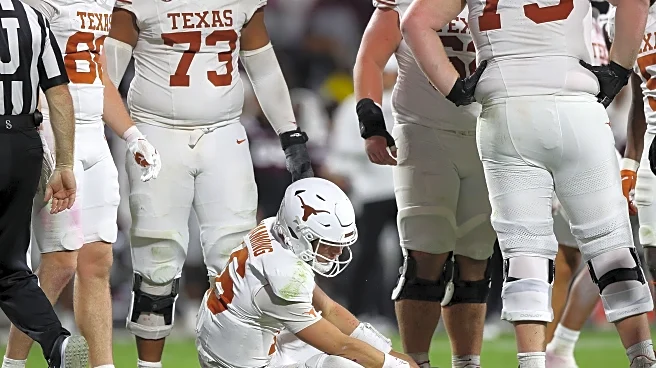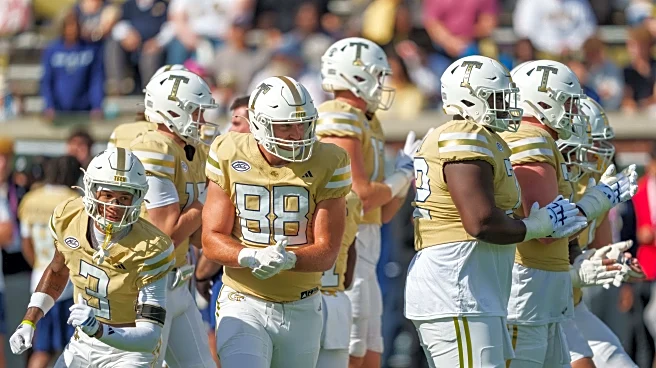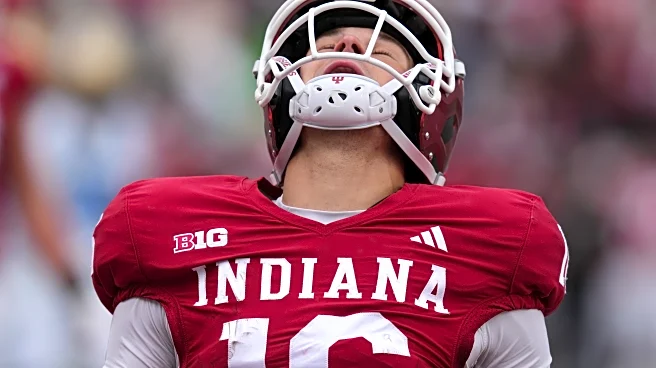For the first time in over a month, the No. 20 Texas Longhorns return to Darrell K Royal–Texas Memorial Stadium to face one of college football’s biggest surprises, the No. 9 Vanderbilt Commodores.
Currently
on an exhilarating ride that’s already flirting with previous best seasons in program history, this Commodore team possesses a magical aura sprinkled with enough toughness to be 7-1 on the year.
Led by ageless quarterback Diego Pavia and head coach Clark Lea, Vanderbilt is a veteran group, with 73 players listed as juniors or older, and has already matched its highest win total in over a decade with four games still to play.
Their formula for success has centered around an efficient, ball-control offense, enough defense, and timely plays, finding different ways to come out on top each week in a “just win” fashion.
“Clark Lea’s done a tremendous job with this program. They know their style of play. They’re an all-three-phase team, and it’s going to take all three phases to battle and compete,” Texas head coach Steve Sarkisian said on Monday.
In conference wins against then-No. 11 South Carolina and then-No. 10 LSU, the Vanderbilt offense averaged 31.0 points per game, but against SEC teams currently ranked in the Top 25, that number drops to 15.5 PPG.
Their most recent outing, a 17-10 win over Missouri, showcased a new path to victory built on defense. Despite being outgained by 111 yards and losing the time of possession battle by a three-to-two margin, Vanderbilt surrendered just 10 points, the lowest total since Sept. 13th. As a last-second Hail Mary by the Tigers fell short of the goal line, the thrilling victory exemplified the toughness that Lea and Pavia have instilled in Nashville.
In his fifth season at the helm, Lea has turned Vanderbilt into a team worth reckoning with. A defensive-minded coach, Lea’s roots to Nashville and Vanderbilt stretch back into his childhood — Lea graduated from Montgomery Bell Academy, a renowned Nashville school, before donning the Black and Gold as a fullback.
As a coach, Lea brings expertise on the defensive side with multiple stints as a linebackers coach before serving as the defensive coordinator at Notre Dame. Perhaps his best decision as a head coach came on the offensive side with the hiring of offensive coordinator Tim Beck, who brought Pavia and tight end Eli Stowers with him to Nashville from New Mexico State.
In the second year with Beck and Pavia, the Commodores are bowl eligible for the second consecutive season, avenged a 16-game losing streak to the Gamecocks, and are ranked in the Top 10 for the first time since 1947.
Offense

The Vanderbilt offense is a modern adaptation of smash-mouth football. While unique formations and creative motions distract opposing defenders with eye candy, this unit’s core identity is punishing defenses by running the ball and sustaining lengthy drives. The Commodores aren’t a traditional triple option team, but do rely on a scheme that gives Pavia three options nearly every play.
Tempo wise, Beck and Pavia are excellent at milking the clock. Vanderbilt ranks 133rd in offensive plays per game and 131st in seconds per play. The Commodores want to slow the game down and use as much as time on offense as possible, a strategy that is highly effective when you lead the nation in offensive points per drive.
“They minimize possessions, they huddle, they shift, they motion, they do a lot of different things offensively, but they limit your possessions. They’re a very efficient offensive football team,” Sarkisian said.
Averaging 6.21 yards per carry, Vanderbilt is third in the nation in YPC, while their 24 rushing touchdowns are tied for the fourth most in the FBS.
The Commodore ground game thrives on Pavia’s athleticism and decision-making. The run-first approach will feature read options, RPOs, and straight QB run calls. Whether Pavia is pulling the ball, deking a defender, or scrambling, the Texas defense must excel in pursuit and open-field tackling of the hard-nosed Vanderbilt quarterback. He leads the team with 85 carries for 458 yards and has five rushing touchdowns, tied for second most for the ‘Dores.
Despite the fact that his legs and demeanor garner more attention, Pavia’s arm is nothing to scoff at. He’s completed 68.8 percent of his passes for 1,698 yards and 15 touchdowns against five interceptions. He is an efficient passer who can layer throws, particularly on the run.
Interestingly, Pavia thrives while being blitzed, but struggles under pressure, a unique paradox. Of his 15 touchdowns, 12 occurred while being blitzed, according to Pro Football Focus. But, under pressure he has three touchdowns while throwing three interceptions and completing less than 50 percent of his passes. If the Longhorns can generate pressure without sending extra defenders, Pavia is likely to make mistakes.
“Obviously, he is the tip of the spear,” Sarkisian said. “He’s one of the more competitive players that I’ve competed against. All the praise that he’s getting is well deserved.”
Helping Pavia in the backfield is local Austin product Sedrick Alexander. Listed at 5’9, 200 pounds, Alexander possesses a nice combination of speed and power despite his smaller frame. The junior from LBJ is the lead back for the Commodores for the third year in a row and has rushed for 388 yards while averaging 5.3 YPC and adding six touchdowns.
While he isn’t a consistent pass catcher, four of Alexander’s 10 receptions have resulted in touchdowns. He is also extremely reliable with the ball, having yet to cough it up in an incredible 384 collegiate touches.
Another New Mexico State transfer, senior running back Makhilyn Young is the backup running back, a 5’10, 210-pound speedster who has made the most of limited opportunities. He averages about six touches per game but has amassed 382 rushing yards and five touchdowns while averaging 12.3 yards per carry.
Stowers is Pavia’s most dependable target. At 6’4, 235 pounds, Stowers is a matchup nightmare, especially when lined up in the slot. He leads the team in receptions (31) and yards (397) while adding two touchdowns, continuing the chemistry he built with Pavia and Beck during their time at New Mexico State. A first-team All-SEC selection and Mackey Award semifinalist last season, Stowers remains the lifeline of this offense.
As a pass catcher, he has soft hands and a natural feel for attacking the ball at its highest point. He possesses enough speed to serve as a vertical threat and enough size to win in the red zone.
In the wide receiver room, Junior Sherrill is WR1 after making a jump from last season. He leads the wideouts in receptions, yards, and touchdowns. Sherrill is a twitchy player with superb speed. Alongside Sherrill is junior Tre Richardson, a transfer from D-II Washburn University. Richardson is a do-it-all athlete with elite speed as verified by a 10.33 100m time while running track at Washburn. He’s contributed 24 catches for 304 yards and a touchdown this year.
Much like the passing game as a whole, the wide receiver room doesn’t jump off the page. Stowers and Sherrill are talented drive extenders that pose matchup problems, but don’t strike fear into opposing defensive coordinators like the ground attack. Given that Texas has been vulnerable against the pass, I’d expect the wideouts to be targeted more frequently than in other Vanderbilt games.
Up front, Vanderbilt utilizes one of the most unique blocking alignments in all of college football. Rather than assigning positions, offensive line coach Chris Klenakis flips the line based on the alignment of the TE, meaning tackles and guards will line up on both sides of the center throughout the game depending on ball location, formation, and play call. Transfers Isaiah Glass and Bryce Henderson anchor the unit, supported by veterans across the interior.
Fifth-year lineman Charlie Clark is also called upon as an extra blocker in short-yardage situations or near the goal line when Vanderbilt opts to use its jumbo package. Like the rest of the fellas up front, Clark combines experience with impressive size. The grad student from Madison, Wisconsin stands 6’7 and weighs 316 pounds.
The revamped offensive line is savvy and efficient. With an unorthodox system, this group has established itself as more than capable of opening running lanes or protecting the pocket. For Texas to slow the Vanderbilt offense, the Longhorn defensive front will need to diagnose and disrupt the experienced Commodore blockers.
Overall, Vanderbilt’s offense is difficult to prepare for. While Alabama and Missouri provided a roadmap on how to disrupt Pavia, replicating it will be no easy task.
Defense

The Vanderbilt defense arrives in Austin coming off its best outing of the season, having previously leaned on a clock-draining offense and the old “bend, but don’t break” adage to mask an otherwise middle-of-the-pack unit. Under first year defensive coordinator Steve Gregory, the group has taken clear steps forward, though there’s still plenty of room to grow.
Thus far, the unit has been stronger against the run — ranking 18th in the nation in tackles for loss and 35th in yards per rush — than against the pass, where they slot in at 70th in pass yards per game and 86th in opposing passer rating.
Other defensive metrics reinforce the “bend but don’t break” mentality. Despite ranking 47th in yards per play and 55th in third-down conversions, Vanderbilt sits 24th nationally in scoring defense. This chasm only widens in SEC play. The Commodores are fourth in scoring defense, but 12th in total defense.
Leading the disruption up front is graduate edge Miles Capers, who leads the team with 4.5 sacks after a promising three-sack campaign last year in his first season at the edge position.
Capers has a knack for big moments and has shown the potential to wreck havoc on an offense, particularly as he’s added strength to his natural burst and developed into an all-around athlete on the edge. This season, he’s playing at around 250 pounds, a 15-pound increase from a year ago, and the added strength appears to be paying off.
Besides Capers, the Vanderbilt defense relies on a seasoned quartet of pass rushers: graduate Khordae Syndor, senior Linus Zunk, senior Keanu Koht, and graduate Zaylin Wood. The group has been active this season with each of the four players recording at least two sacks, contributing to a team total of 21, which ranks seventh in the SEC.
At the linebacker position, Vanderbilt has top-end talent, experience, and depth. Returning starters Bryan Longwell and Langston Patterson are a tough and reliable duo up the middle. Longwell is a Nashville native with 33 career appearances while Patterson led the team in tackles as a sophomore and finished second last year.
Behind Patterson and Longwell, Longhorn fans should expect to regularly see senior Nick Rinaldi with flashes from senior Bryce Cowan. Rinaldi has been particularly impactful off the bench, contributing 24 tackles and two sacks this season.
At the Star position, junior Randon Fontenette has continued to be a disruptor after an excellent campaign last year. The 6’2, 220-pound standout has an all-around skillset that allows him to rush the passer and play in coverage from his hybrid spot.
While he hasn’t reached the same production in bringing down the quarterback, Fontenette remains a key cog in the defense. He’s improved as a leader and open-field tackler, two areas that have helped improved the entire defense.
At the corner spots, graduate transfer Kolbey Taylor and junior Martel Hight are a shaky duo. Taylor is a versatile athlete, but lacks elite speed, often forcing him to give up a sizable cushion at the line of scrimmage to compensate for the lack of speed. Meanwhile, Hight has struggled down the field and misplayed balls in the air.
This unit lacks top-end physical attributes and often has to compensate with technique and effort. While there are flashes of solid fundamentals on film, corners are ultimately judged by their mistakes and this duo makes more than you’d like as a Vanderbilt fan. If the Longhorns can neutralize the Commodores’ pass rush — a big if — the corners are vulnerable.
Minimizing the shortcomings of the corners are safeties CJ Heard and Marlen Sewell. Despite losing both starters from a year ago, Vanderbilt’s last line of defense has arguably improved. In his first year as a Commodore, Heard has already established himself a playmaker. The sophomore transfer from FAU leads the team in tackles (43) and turnovers created (one interception, one forced fumble).
Sewell, a two-year team captain, has been challenged to evolve from vocal leader to on-field producer. Remarkably, he earned the captain title last season despite serving as a backup, but then entered the transfer portal at the conclusion of the season. When the dust settled, Sewell opted to return to Vanderbilt and he’s made the most of it. The 6’1, 205-pound fifth-year senior has already recorded a career high in tackles.
As a whole, the Vanderbilt defense is a tenacious group with plenty of experience and talent, particularly the front seven. Facing a hybrid defense that mixes blitz looks, the Texas offensive line will be tested repeatedly on Saturday. If Texas is able to establish a resemblance of a run game and create a clean pocket, windows will open up in the Commodore defense, especially through the air.
Special teams

Vanderbilt kicker Brock Taylor is leading the SEC in kicking with a perfect 7-of-7 mark on field-goal attempts. The Commodores are the only team to attempt less than 10 field goals on the year, a testament to their offensive approach and ability to execute near and within the red zone.
Vanderbilt has also punted the fewest times in the SEC (17), but when called upon, graduate transfer Nick Haberer is a weapon. The Aussie ranked 11th nationally in hang time at Washington State, a factor that has helped the Vanderbilt coverage unit hold opponents to just 5.5 yards per return with no significant runbacks.
In the return game, Tre Richardson brings explosiveness, averaging 27.9 yards per kickoff return — fourth in the SEC — while cornerback Martel Hight averages 9.1 yards per punt return.
To state the obvious, this is a huge game. As if defeating a top-10 opponent and Cinderella QB isn’t enough, the Longhorns still possess an outside shot of making the College Football Playoffs. That long shot is all but eliminated with a loss on Saturday against a Vanderbilt team that is hungry for revenge after last season’s loss.
The Longhorns defense matches up well against the Commodores offense. A strong Texas front will look to counter Vanderbilt’s ground game in what should be a physical battle up front. Stopping the run, tackling in space, and keeping Pavia contained will be key to getting off the field.
On offense, Texas must protect the quarterback to take advantage of a vulnerable Vanderbilt secondary. With the Commodores’ slow tempo, the Longhorns can’t afford missed chances or negative plays.
Overall, this has the makings of a low-possession, grind-it-out game. Success on third downs, red-zone efficiency, and winning the turnover battle could ultimately swing this contest in favor of the Longhorns.
